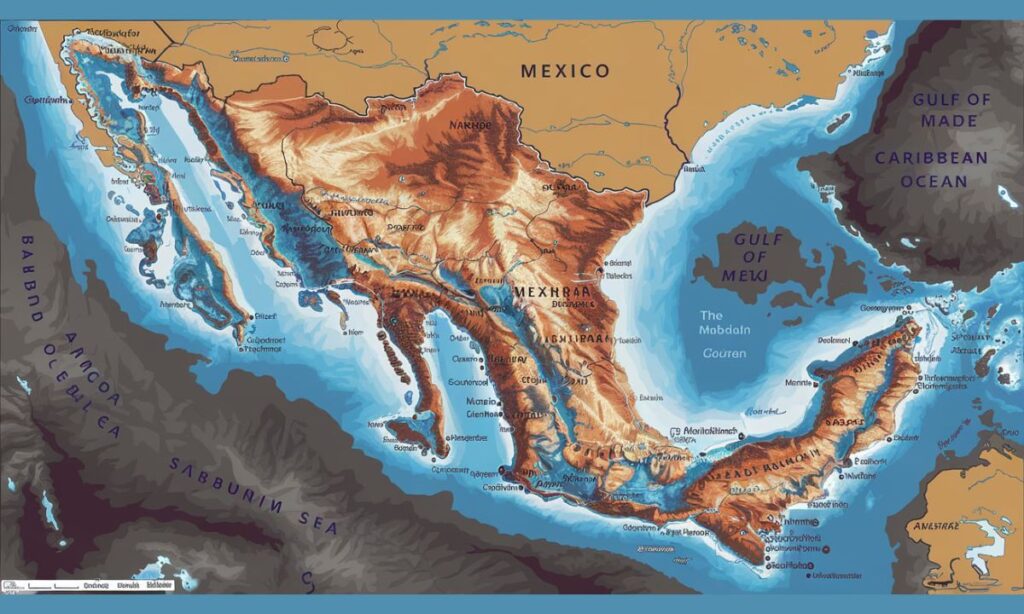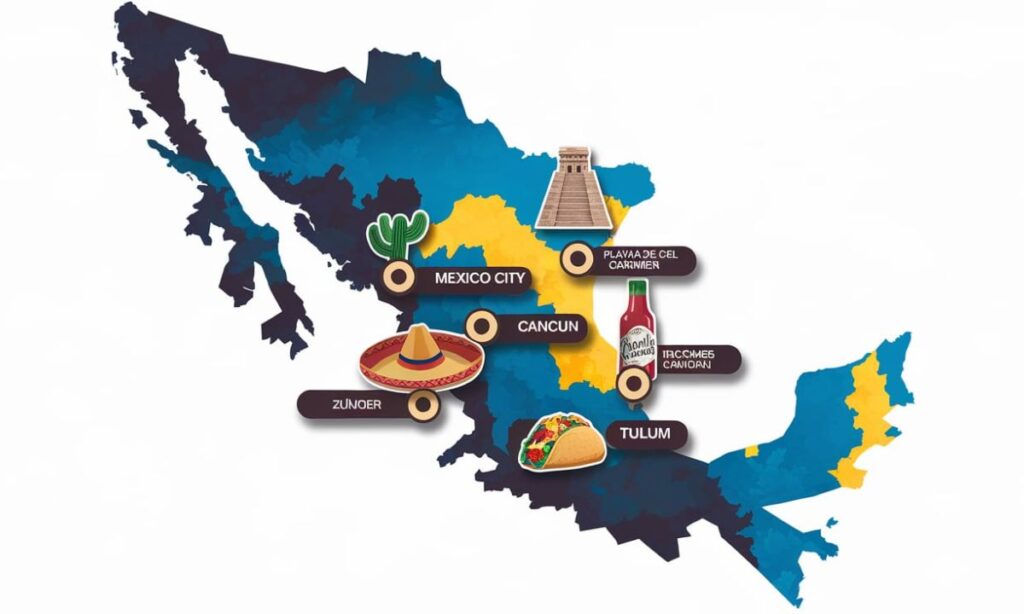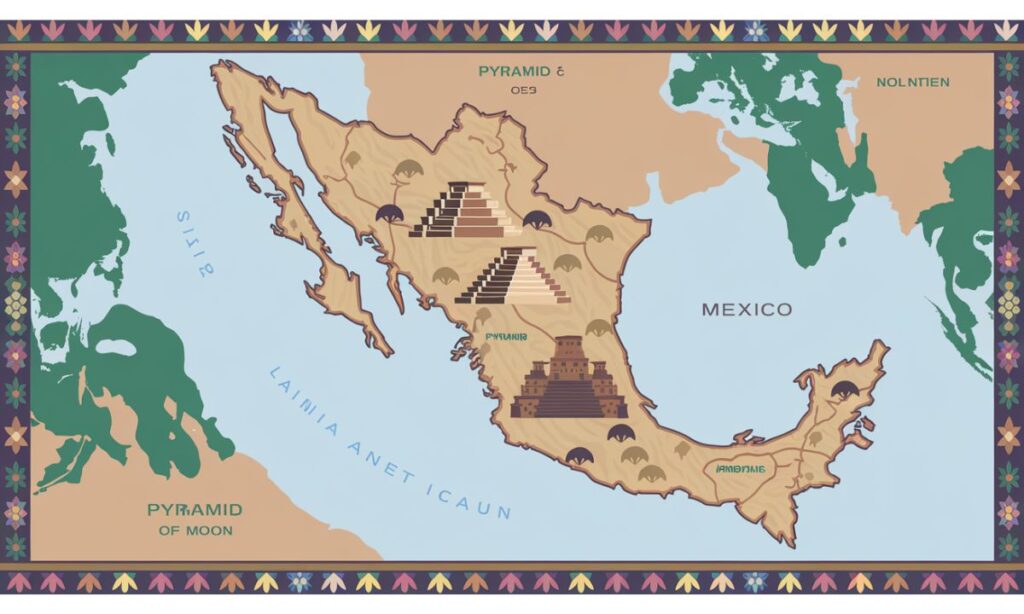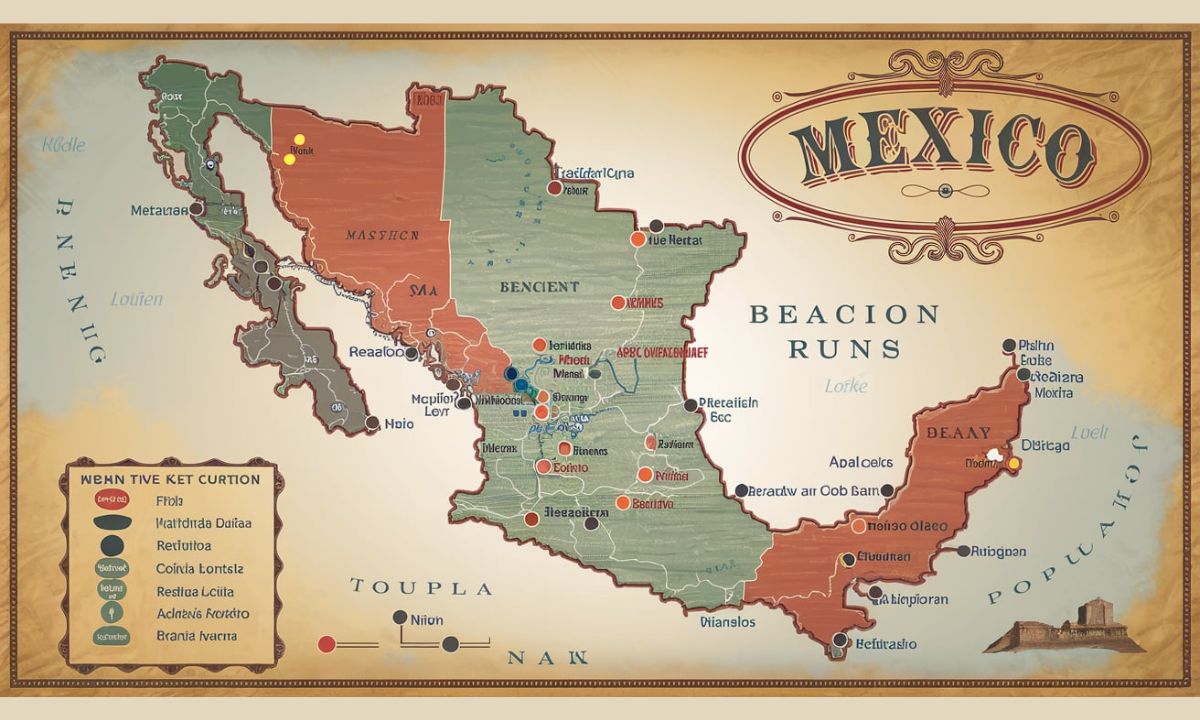Mexico, a land of contrasts, offers a rich tapestry of landscapes, cultures, and experiences. This comprehensive guide to map:danhyf_d1wi= mexico will take you on a journey through the country’s varied regions, from the sun-baked deserts of the north to the lush rainforests of the south.
Whether you’re planning a trip or simply want to expand your knowledge, this guide will provide valuable insights into Mexico’s geography, culture, and attractions.
Northern Mexico Deserts and Mountains
Northern Mexico is a land of stark beauty, dominated by arid landscapes and towering mountain ranges. This region is characterized by the Chihuahuan Desert, which stretches across several states including Coahuila and Durango. The desert is home to unique wildlife adapted to the harsh conditions, such as the desert bighorn sheep and the Mexican prairie dog.
Key Features:
- Chihuahuan Desert: One of North America’s largest deserts
- Sierra Madre Occidental: A major mountain range running along the western coast
- Rio Grande: Forms part of the border between Mexico and the United States
The Sierra Madre Occidental mountain range plays a crucial role in shaping the region’s climate, creating cooler temperatures at higher elevations. This diverse landscape supports a variety of ecosystems, from desert scrublands to pine-oak forests.
Monterrey, the capital of Nuevo León, stands as a testament to Northern Mexico’s economic prowess. Known as the “Sultan of the North,” it’s a major industrial and financial center, blending modernity with traditional Mexican culture.
Southern Mexico Tropical Rainforests and Coastal Beauty
In stark contrast to the north, Southern Mexico is a verdant paradise of tropical rainforests and stunning coastal areas. This region is home to the Yucatán Peninsula, famous for its Mayan ruins and pristine beaches along the Caribbean Sea.
Facts about Southern Mexico:
- Home to ancient Mayan ruins like Chichén Itzá
- Boasts some of Mexico’s most popular beaches, including those in Cancún and Tulum
- Rich in biodiversity, hosting numerous species of plants and animals
The Zapotec civilization, one of the earliest Mesoamerican cultures, flourished in this region, leaving behind impressive archaeological sites like Monte Albán in Oaxaca.
Eastern Mexico Gulf Coast and Cultural Richness

Eastern Mexico’s Gulf Coast is a region of immense cultural and historical significance. Veracruz, one of the oldest European settlements in Mexico, serves as a gateway to this vibrant area. The region is known for its:
- Colonial history and architecture
- Vibrant cultural festivals, including the famous Carnaval de Veracruz
- Rich culinary traditions, blending indigenous, African, and Spanish influences
Tamaulipas, another Gulf Coast state, is crucial to Mexico’s economy due to its oil production and fishing industry. The region’s warm waters and sandy beaches attract tourists year-round.
Western Mexico Pacific Coastline and Tourism
The Pacific Coastline of Western Mexico is a paradise for beach lovers and adventure seekers alike. This region is home to some of Mexico’s most famous beach destinations, including:
- Puerto Vallarta: Known for its stunning beaches, vibrant nightlife, and backdrop of lush mountains
- Mazatlán: The “Pearl of the Pacific,” famous for its historic old town and beautiful beaches
- Acapulco: Once a playground for Hollywood stars, still offering breathtaking views and exciting marine activities
The Pacific Coast is also an excellent spot for whale watching, particularly in the winter months when gray whales migrate to the warm waters off Baja California.
The Baja Peninsula Unique Geography and Attractions
The Baja Peninsula is a long, narrow strip of land extending south from California. Its unique geography creates diverse ecosystems, from desert landscapes to rich marine environments. Key attractions include:
- The Sea of Cortez, dubbed “The World’s Aquarium” by Jacques Cousteau
- Cabo San Lucas, famous for its distinctive rock formation and luxury resorts
- Valle de Guadalupe, Mexico’s premier wine region
The Yucatán Peninsula Historical and Natural Wonders
The Yucatán Peninsula is a treasure trove of historical and natural wonders. This region was the heart of the Mayan civilization and continues to captivate visitors with its archaeological sites and natural beauty.
Key Historical Sites:
- Chichén Itzá: One of the New Seven Wonders of the World
- Tulum: A stunning Mayan ruin perched on coastal cliffs
- Uxmal: Known for its Puuc-style architecture
The peninsula is also famous for its cenotes, natural sinkholes filled with crystal-clear water, which were sacred to the Maya and now serve as popular swimming spots for tourists.
Mexico’s Major Rivers and Lakes

Water resources play a crucial role in Mexico’s geography and economy. Here’s a breakdown of some major water bodies:
Major Rivers:
| River Name | Length (km) | States it Flows Through |
| Rio Grande | 3,034 | Chihuahua, Coahuila, Nuevo León, Tamaulipas |
| Usumacinta | 1,000 | Chiapas, Tabasco |
| Grijalva | 766 | Chiapas, Tabasco |
Major Lakes:
- Lake Chapala: The largest freshwater lake in Mexico
- Lake Pátzcuaro: A high-altitude lake in Michoacán
- Laguna de Términos: A large coastal lagoon in Campeche
Climate Zones and Regional Differences
Mexico’s diverse geography results in a variety of climate zones, each with its own characteristics:
Climate Breakdown:
- Tropical rainforests in the south: Hot and humid year-round
- Arid deserts in the north: Hot days and cool nights, with little rainfall
- Temperate zones in central highlands: Mild temperatures and moderate rainfall
This climatic diversity allows for a wide range of agricultural products and influences local cultures and lifestyles.
Economic Regions and Industrial Areas
Understanding the map:danhyf_d1wi= mexico is crucial for grasping the country’s economic landscape. Different regions specialize in various industries:
Key Economic Activities by Region:
- North: Manufacturing, particularly in border cities like Tijuana and Ciudad Juárez
- Coastal areas: Tourism, especially along the Riviera Maya and Pacific Coast
- Central valleys: Agriculture, with crops like corn, beans, and agave for tequila production
Cultural and Linguistic Diversity

Mexico’s map is not just about geography; it’s also a representation of the country’s rich cultural tapestry. With over 68 indigenous languages recognized by the government, Mexico is a linguistically diverse nation.
The distribution of these languages often correlates with geographical regions, reflecting the historical movements and settlements of various indigenous groups.
Conclusion about map:danhyf_d1wi= mexico
The map:danhyf_d1wi= mexico is more than just lines on paper; it’s a gateway to understanding the country’s rich diversity. From the deserts of the north to the rainforests of the south, from ancient Mayan ruins to modern industrial cities, Mexico offers a wealth of experiences and opportunities. Whether you’re a traveler, a business person, or simply curious about our southern neighbor, understanding Mexico’s geography is key to appreciating its complexity and beauty.
As you plan your Mexican adventure or business venture, remember that each region has its own unique character, shaped by its geography, history, and people. The map:danhyf_d1wi= mexico is your key to unlocking these diverse experiences and opportunities.
Frequently Asked Questions about map:danhyf_d1wi= mexico
Where is the Mexican desert in Mexico?
The Chihuahuan Desert covers much of Northern Mexico, spanning parts of Chihuahua, Coahuila, Durango, and Zacatecas states.
What’s next to Mexico?
The United States borders Mexico to the north, while Guatemala and Belize border it to the southeast.
Where is Mexico on the world wide map?
Mexico is located in North America, occupying the southern portion of the continent.
Where is Mexico localized?
Mexico is situated between 14° and 33° N latitude, and 86° and 119° W longitude.
Where is Mexico located?
Mexico is located in the southern part of North America, bordering the United States to the north and Central America to the south.
What countries surround Mexico?
Mexico is surrounded by the United States to the north, Guatemala and Belize to the southeast, the Pacific Ocean to the west, and the Gulf of Mexico and Caribbean Sea to the east.
What is the geolocation of Mexico?
Mexico’s approximate center point is at 23°N latitude and 102°W longitude.
What is the currency of Mexico?
The currency of Mexico is the Mexican Peso (MXN).








